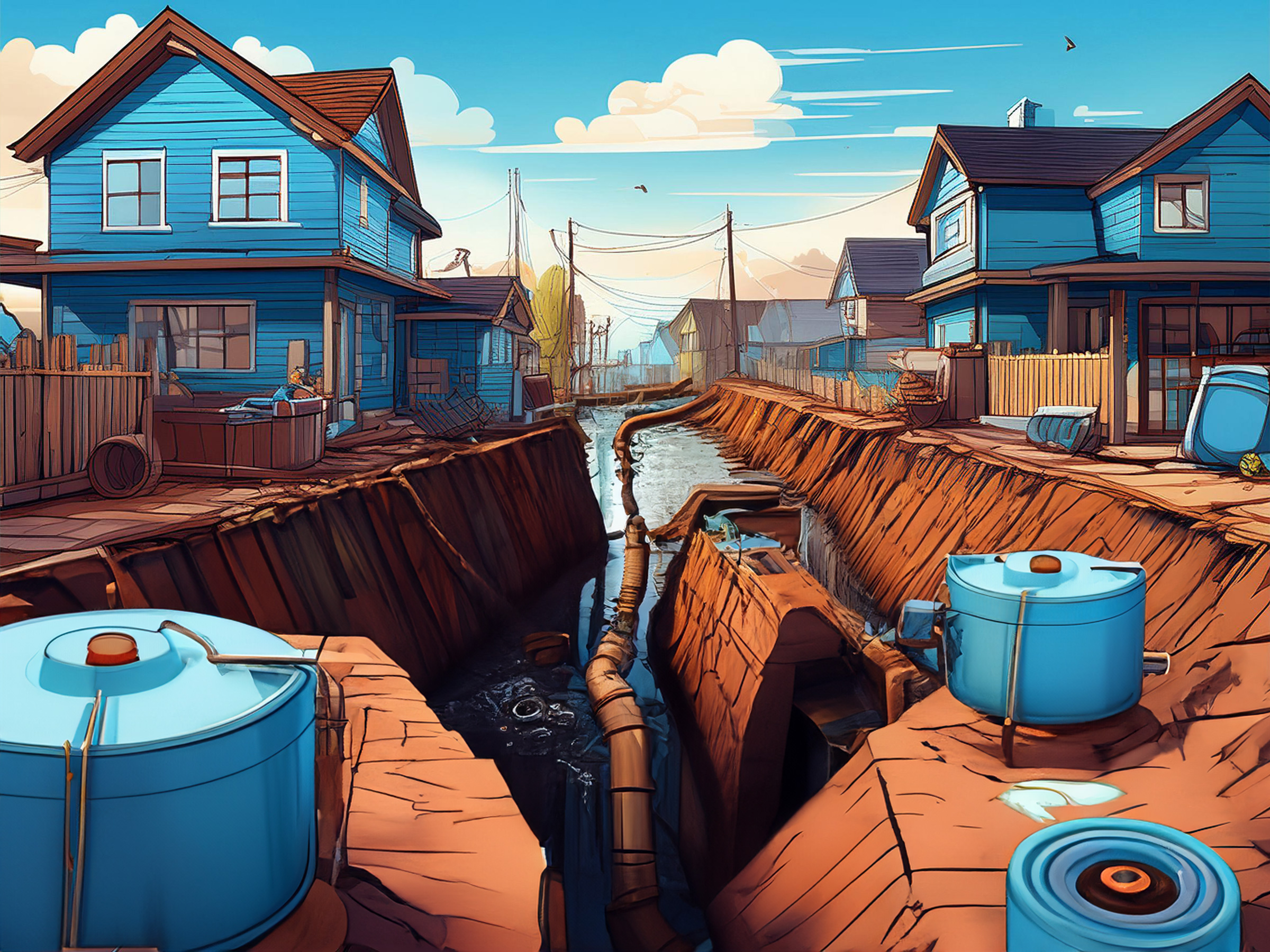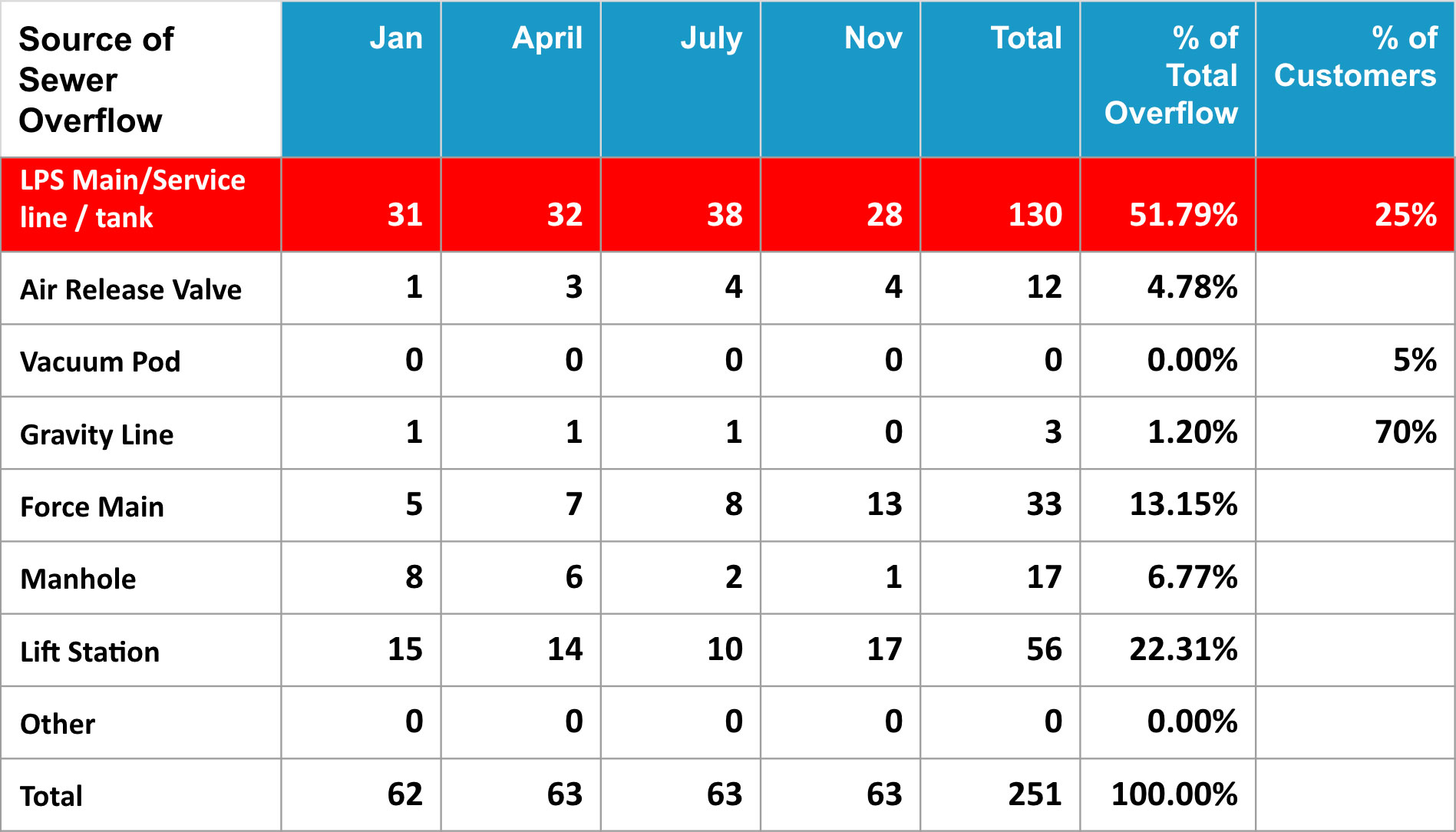Why We Don’t Want a Low-Pressure System
Most of us do not think much about what happens after we flush the toilet. But there is a world of infrastructure and technology options out there. This page covers the three primary types of central sewer systems and why we don’t want a low-pressure system.
Three Main Types of Sewer Systems
Gravity Sewers
Gravity sewers use large pipes trenched in a slow downgrade to move sewage. They are used in extreme high-density areas, such as you would find in major cities and municipalities. This type of sewer is not applicable on our Island.
Vacuum Sewer
A Vacuum Sewer system maintains a partial vacuum inside the pipe network and vacuum station. A single central vacuum station (also called a lift station) can collect the wastewater of several thousand individual homes, depending on terrain and the local situation. Vacuum systems can be found in flat areas which have a high water table. Pipework is laid relatively flat in the ground and the whole intention of this type of system is to ensure that construction remains as shallow as possible. This reduces costs, time and environmental impacts.
Low-Pressure Sewer
Low pressure sewer systems use a grinder pump station located at each house to move wastewater through the transmission system. They can often be used when connecting outlying homes or developments to municipal central sewer. However, there are many downsides to consider with grinder pumps.
Low Pressure Systems Leak
A low-pressure system is the least desirable sewer system available. Due to high maintenance costs, Charlotte County has stopped using low-pressure systems in new installations unless it is the last possible option.
From 2017 through November 2024, Charlotte County data shows that their sewer systems have spilled almost 4 Million gallons of sewage. 22% of those spills, 839,748 gallons, have found their way into our water ways. These massive spills affect our soil, water quality, wildlife, plants and overall ecosystem.
Charlotte County Sanitary Sewer Overflows
* Partial year, data through 10/29/24
Excessive Cost
Low pressure sewer systems are very costly for the homeowner. Want to know how much this is all going to cost you? Click here to learn the realistic cost >
They Break More Than Other Sewer Types
According to data from Charlotte County data, low pressure sewer systems contribute disproportionately to sewer spills. Despite making up only 25% of the county’s sewer systems, they are responsible for over 51% of all reported spills.
Charlotte County 2024 Sanitary Sewer Overflows
- Shortened Equipment Lifespan: The salt air on the island significantly reduces the lifespan of low-pressure sewer system components, leading to frequent replacements and increased maintenance costs.
- High Maintenance Requirements: Pumps and other mechanical parts in a low-pressure system require regular servicing and repairs, which can be challenging and costly in a remote, coastal community.
- Vulnerability During Storms: Low-pressure sewer systems are highly susceptible to failure during storms or hurricanes, leaving the community without functional waste management when it is needed most.
- Power Dependency: These systems rely on electricity to function, making them prone to outages during severe weather events, requiring backup systems or emergency measures.
Environmental Risks
- Higher Leak Probability: Central sewer systems carry a greater risk of leaks compared to individual septic systems, potentially impacting larger areas and more properties.
- Greater Sewage Discharge in Leaks: Pressurized systems can release significantly more sewage during a leak compared to gravity or vacuum systems, leading to larger-scale contamination.
- Visible and Hidden Risks: Leaks in pressurized systems can result in small geysers of sewage or, worse, seep undetected into the ground, contaminating soil and groundwater until noticeable odors reveal the problem.
- Environmental Contamination: The potential for undetected leaks in pressurized systems poses a serious threat to the island’s ecosystem, affecting soil, water quality, and surrounding habitats.
- Ecological Impact: Our unique ecosystem, which supports diverse wildlife and plant species, could suffer irreversible damage from even minor spills and the infrastructure required for low pressure sewer systems.
- Public Health Hazards: Leaks from pressurized systems can introduce harmful pathogens into the environment, increasing the risk of health issues for residents and wildlife.
- Septicity: In seasonal communities, low-pressure sewer systems can lead to prolonged periods where sewage remains stagnant in force mains. This extended retention time can cause the sewage to become septic, resulting in unpleasant odors, corrosion of infrastructure, and potential environmental concerns.
Intrusive to Personal Property
- Access: For any repairs or replacements to the grinder pump, utility operators are required to go onto homeowner’s property to do any maintenance which may result in sewage spilling over gardens or lawns. Access may also prove problematic if there are dogs or after dark. (All gravity and vacuum sewer infrastructure is on public land so no access is required.)
- Easements: Homeowners are required to simply give up a potentially 15′ wide path through their property to the sewer company. This means you can never build or do anything on it. Depending on where the pump is put, this could mean the middle of your land, the space right in front of your golf cart parking or garage. If you refuse to grant this, your land can be seized by eminent domain.
Undue Burden on the Homeowner
- Electrical Subpanel Installation: The utility company (EU) will provide the electric subpanel, but you will need to hire a licensed electrician to install it.
- Permit Requirements: Either you or your electrician must handle pulling the required permits for the installation.
- Potential Electrical Panel Upgrade: If your main electric panel is already at capacity due to heavy-draw equipment like a pool, hot tub, or boat lift, you may need an expensive panel upgrade, which must be arranged through Florida Power & Light (FPL).
- Plumbing Modifications: You’ll need to hire a plumber to reroute the pipes currently connected to your septic system to connect to the new sewer tank.
- Plumbing Permits: You or your plumber will also be responsible for obtaining the required permits for this work.
Where Can This New Tank Go?
- The new grinder pump equipment must be installed close to your house.
- It cannot be placed where your existing septic tank is located.
- The current septic tank will be “crushed and filled,” meaning it will be collapsed in place (leaving the concrete or fiberglass underground) and the hole filled with sand.
- Since the existing tank location will be unusable, a new spot must be found for the grinder pump.
- The new location must be accessible by the utility equipment, which is why a possible 15-foot easement is required.
- The grinder pump must be installed close to where the sewage pipe exits your house.
- If it is not, you will need to run additional piping across your property to connect it to the new location.
- For many homes where the septic tank is on the side of the house, this may mean placing the new tank in front of the house, potentially obstructing parking or garage access.
- Landscaping and hardscaping around the installation site must be cleared for both installation and ongoing servicing.



